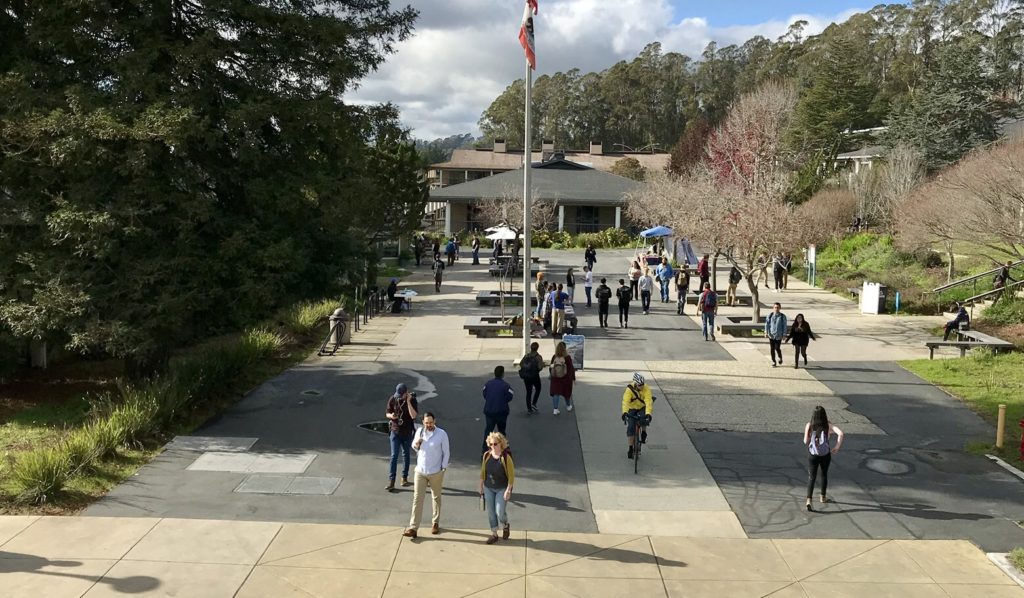On Feb 1, Cabrillo College submitted its funding proposal for a $181.7 million joint student housing project with UCSC. If successful, Cabrillo will receive $111.7 million from the state, with UCSC financing the other $70 million from its own funds subject to approval from the Board of Regents and UC Office of the President.
Consisting of 271 total units, 115 dormitories, 96 apartments and 60 apartments reserved for families, the project would add a total 624 beds to Santa Cruz County’s impacted housing market, roughly 383 of which would be reserved for Cabrillo students and subject to the state’s affordability cap on rent, set at 30% of 50% of the area’s median income for single occupancy households. UCSC would rent its roughly 241 beds in line with the rest of its student housing system.
With a final average rent of $874, Cabrillo’s proposed affordable beds come in $22 under the initial $896 rate approved by Cabrillo’s board of trustees, putting the college in a slightly better position to be chosen for funding from California’s $2 billion Higher Education Student Housing Grant Program.
“We’re setting that rate that low because we’re intentionally agreeing to put in the lowest income and most needy students,” said Cabrillo President Matt Wetstein. “For us to use the state money, we have to promise to give the slots for our beds to students who are most needy. So that does include homeless students, and includes people that have zero estimated family contribution to their education.”
The rents could have been even lower, Wetstein estimates, but the school ultimately decided to include a daycare center for the children of families living in the family student wing. While keeping the rents as low as possible may have looked good to the state on paper, Wetstein argues that the inclusion was justified.
“We’re not going to put forward a project that doesn’t provide services the students need,” he said, referring to the necessity of child care for student parents. “We could have built something without a child care center, but that’s just perpetuating the problem of lack of child care facilities in our county.”
To qualify for the funding, colleges have to charge for rent no more than 30% of 50% of the median area income for single occupancy households, estimated to be $939 for Santa Cruz county. That funding can only be used to construct beds that are rented below that maximum threshold so as to ensure that housing remains accessible to low-income students.
“You cannot borrow that amount of money and then charge the low rents that you’re talking about,” says Wetstein.
While no beds are expected to be set aside for particularly housing insecure groups such as Black, Indigenous, and People of Color (BIPOC), LGBT and former Foster Care students, Wetstein argues that the new units would disproportionately house them. Whether or not that would happen in reality, even some families who would have beds set aside for them could be hard-pressed to take the opportunity.
Lisa Loretz, 33, who is a formerly incarcerated veteran and single mother of two, says however that even with the supposedly affordable rents projected for the family wing set at just under $1000 per month, she wouldn’t be able to afford it without the GI bill she is entitled to as a veteran. Currently living in a Sober Living Environment that charges her 30% of whatever income she makes, whether that ends up being $100 or $1000, she is able to go to school for nursing, be a mother, and earn some money working.
“With just FAFSA (Federal student aid available to most low income students), no. With kids, I don’t think so, especially while they’re trying to get through school.”
In an October 2021 study the college has relied upon to inform its housing proposal, the county’s average asking rent per unit was estimated to be $2,241, growing at a rate of 5% year over year. According to Wetstein, that study suggests that a sufficient demand exists for beds with rents at or below $1000/month to be attractive enough to compete for a grant that makes low income rents at the college possible in the first place.
The college is confident that there are enough students seeking rentals at that price to fill the housing project if it is constructed, but some believe the proposed housing would likely help some while leaving out others.
“It could provide support for the insecurely housed,” says Page Stein, a 28 year old Cabrillo student waiting for her next class. “Compared to the situation currently, it’s affordable. For someone just out of highschool, it isn’t affordable.”
Approximately 60% of California Community College students experienced some form of housing insecurity in a 2017 survey of the school system by The Hope Center. That number includes everyone from those who report difficulty in paying for a rent increase to those who were summoned to a housing court as part of an eviction. Homeless students were identified at nearly 20%, though that number includes those who stay with a relative for a few nights in addition to those sleeping in their car every night. Self identified homeless students were counted at 6%, a number that could be underreported given the stigma associated with homelessness.
On the other hand, 19 year old sophomore Heidi Dyer, herself living in a single dorm-style room on the UCSC campus, says the Cabrillo rate would be affordable to someone like her.
“I’d love that,” she says in response to the idea of living at the Cabrillo campus and paying the more affordable rent. Currently, she spends nearly $1600 on her single-bed dorm at the Stevenson campus.
As a UCSC student however, she wouldn’t be able to access the affordable beds, as UCSC has yet to determine what it will charge for its own share of the housing.
“I wouldn’t be able to afford it without loans,” she says of her on-campus dorm. “I would be able to afford [the Cabrillo rate].”
Heidi attends UCSC as a full time student and works 30 hours a week as a barista on the Cabrillo campus, so her time is already split between the two. Given the bus situation between the two campuses however, where a bus trip requires a transfer and can take an hour, sometimes more in traffic, she thinks she would need her car.
“Without it, probably not,” she says.
Now that the 91X direct line between Cabrillo College and UCSC has been indefinitely suspended, many students may feel the need to drive a car in order to feasibly live there, increasing overall trip miles between the two campuses and concordant greenhouse gas emissions. And given that the project adds no new parking spaces for students who would live on campus, parking could be negatively impacted.
The proposal would be among the first in the state to merge housing between a UC campus and a California community college. The colleges initially combined their grant proposal to be more appealing to the Chancellor’s Office, which awards the grants based on a set of priorities having to do with an area’s housing need, the top two of which consider a project’s cost to the state per bed and the proposed rental rate in relation to the allowed maximum. By coming in lower than that threshold, Cabrillo improves its chances for receiving construction grant funding, Wetstein said.
“I would say we have a one in, I don’t know, one in seven chance?” speculated Wetstein. “We’re competing against colleges in our region. If you think about the math (of the total budget), they might build seven projects statewide. They should be under state law sprinkling those around.”
Though realistic about Cabrillo’s chances, Wetstein is hopeful for the funding. He believes however that residents have a part to play in bringing more funding to Cabrillo specifically, and California Community Colleges generally.
“To the extent that people can be vocal and continue to voice the need, it’s really important to keep the legislature and governor focused on building these kinds of projects.”
“Universities and Colleges have land. If they’re public agencies like Cabrillo, or UCSC or CSU Monterey Bay, the taxpayers already own the land, so you do not have to pay for land so you can build these things at less cost, more efficiently, faster, because the land exists. IT’s a solution to the problem that’s easy to advance because of that affordability part of it.”
“The more that we can keep people with their eye on the ball – that there are no ways to solve this problem unless we build housing – these are really good, attractive ways to spend the money to get housing faster.”





